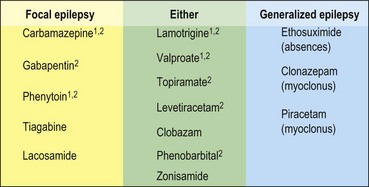Epilepsy II
Treatment and management
Principles of medical treatment
Some refractory cases, on re-evaluation, prove to have non-epileptic (psychogenic) seizures, also referred to as pseudoseizures (p. 116). In others, poor compliance contributes to poor control.
Choice of medication
The major divisions into generalized and focal-onset epilepsies are important in the choice of drug (Fig. 1). Medications can broadly be divided into those useful in focal epilepsy, those with a broad spectrum of action and those for specific seizure types. Carbamazepine, lamotrigine and valproate are the commonest first-line drugs in the UK. The choice is also heavily influenced by the age of the patient because this affects their susceptibility to the side effects of different drugs. For example, focal-onset epilepsy in a young woman is often treated with carbamazepine or lamotrigine as first line because of its lower risk of teratogenicity, but sodium valproate is favoured in the elderly because of a lower risk of ataxia and falls. Lamotrigine is emerging as a broad-spectrum drug, well tolerated in many patient groups.
Adverse effects
The adverse effects of antiepileptic drugs are common and major adverse effects are listed in Table 1. Sedation can occur with all drugs and is the most common complaint, especially with polytherapy. Another concern is teratogenicity. Women of childbearing age on antiepileptic medication should be counselled of the risk and their medication minimized prior to conception. Although not proven to be of benefit, folic acid supplements (5 mg daily) are generally prescribed to women of childbearing age taking antiepileptic drugs as it may help to prevent neural tube defects. The risk of major malformations for a woman taking anticonvulsants is about 4–9%, compared with about 1–2% in the general population. It is highest for those on valproate and on multiple drugs.
Stay updated, free articles. Join our Telegram channel

Full access? Get Clinical Tree






